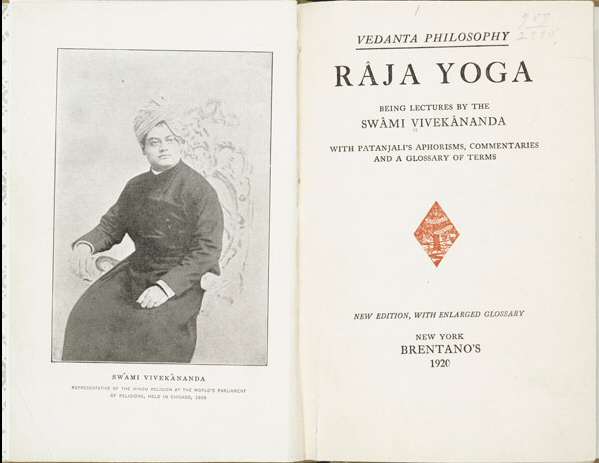“Raja
Yoga” is a famous book by Swami Vivekananda, first published in 1896.
Vivekananda was the founder of the Ramakrishna Mission and one of the first
Hindu teachers to visit the United States. He is often regarded as a Hindu
reformer, Neo-Hindu or Neo-Vedantin. According to De Michelis´ book “A History
of Modern Yoga”, Vivekananda was heavily influenced by Western neo-esotericism,
including New Thought and Transcendentalism. If so, I didn´t get it, since I
think “Raja Yoga” sounds traditional enough. But then, at least in the West, this
is how almost every Hindu or Buddhist teacher sounds like, no doubt due to the
success of “Raja Yoga” back in the days. I suppose you could say that it has
become “traditional” after a fashion. Presumably, the original audience gasped in
awe and wonder at the swami´s teachings…
The book
is divided into two sections. The first contains a number of lectures on the
topic of Yoga. The second is a series of commentaries on Patanjali´s Yoga
aphorisms. The term Raja Yoga refers to Patanjali´s system and is Vivekananda´s
own designation of it. One thing that immediately struck me was that
Vivekananda doesn´t connect yoga to any health benefits, the power of positive
thinking or what have you. No New Age fare in this one! Yoga is forthrightly
said to be a mystical technique to attain either godhood or complete liberation
from the material world. The next thing that struck me was how freely
Vivekananda talks about some pretty extreme practices. He accepts both hatha
yoga and kundalini yoga, indeed, Raja Yoga seems to be a form of kundalini
yoga. He also seems to accept that yogis can attain supernatural “siddhi”
powers and essentially become “gods”. The author even mentions alchemical
attempts (via mercury and sulfur) to make the physical body immortal. As usual,
siddhi powers and godhood is said to lead away from liberation, and the yogi
should therefore renounce them in order to attain genuine enlightenment.
Vivekananda
points out that Yoga is based on the ancient Indian philosophy known as
Samkhya. This is something of a problem, it seems, for many Hindus. Samkhya
could be described as an atheistic and ontologically realist form of dualism.
There is no creator-god, but rather an infinite number of spirits or “purushas”,
many of whom are stuck in the material world for eons before attaining
liberation. The world is real, not a mayic illusion. And since all spirits are
distinct from each other, there is presumably no Brahman either. I suspect that
many Hindus, while generally appreciative of Patanjali, nevertheless want to complete
his system by introducing a creator-god, a kind of Über-Purusha controlling the
entire cyclical process of the world. Others want the world to be an illusion
and are hence monists. It´s not clear to me exactly what Vivekananda wants, but
he treats the Purusha as one. The Purusha is a trans-personal (critics would
say impersonal) god permeating the entire cosmos and somehow also standing
outside of it. Unity with this divine reality is the goal of Raja Yoga. The
author emphasizes the distinction between pre-personal and trans-personal
states (today, this is the shtick of Ken Wilber and his fans) and occasionally
sounds like a Theosophist, when he argues in favor of a cyclical
involution-evolution.
“Raja
Yoga” is not a textbook of instructions, although Vivekananda does mention a
few typical practices, such as the importance of a correct body posture or
various exercises involving inhalation and exhalation. He also discusses
mantras. Following Samkhya, the author argues that sense perception or
empirical experience is the ultimate ground of all knowledge. Of course, he regards
mystical experiences as empirical. The only true religion is the one that isn´t
based on blind faith, but invites people to come and see for themselves. In
this particular book, Vivekananda seems to regard all “official” religions as
false, while in other works, he rather emphasizes that most people can´t attain
liberation unless they worship a personal god or even a human saint, although the
ultimate goal can only be the trans-personal Divine. An ironic confirmation of this
is that Vivekananda´s admirers on YouTube claim that he was actually Shiva! It
seems some people can´t be liberated from samsara without worshipping a
personal destroyer-god in the shape of one Narendranath Datta from Calcutta…
The
edition of “Raja Yoga” I have on my desk has a sub-title not present in the
original: “A Scientific Method for Mental Modification”. This kind of “scientism”
is rather typical of the New Age. As already indicated, however, there is very
little New Age feel in this work. If anything, it has a “Buddhist” vibe,
perhaps because a Western reader like yours truly rightly or wrongly associate “atheistic
dualism” with Buddhism. I think “Raja Yoga” can be read with some benefit by those
seriously interested in real yoga, and it could also be important for students
of comparative religion, the history of religion, and the contemporary
spiritual landscape.

No comments:
Post a Comment